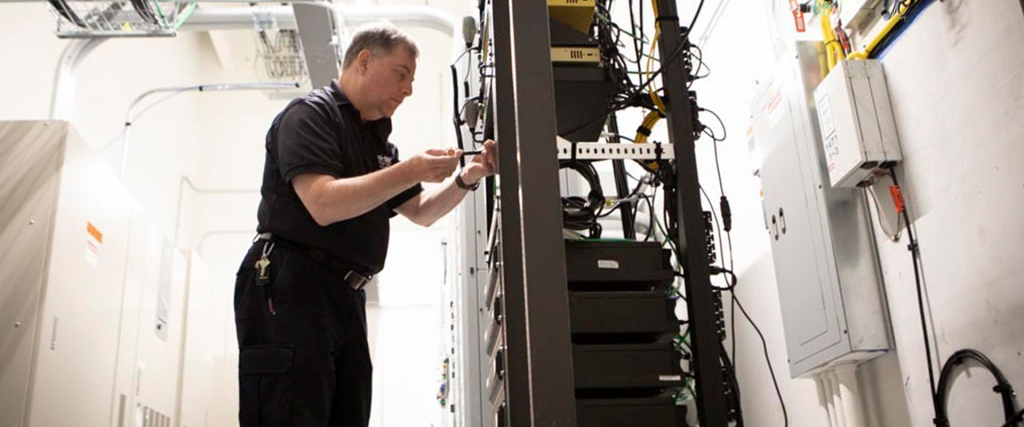In this modern age of connectivity, where seamless communication is the lifeblood of our daily activities, the significance of robust in-building coverage solutions cannot be overstated. Beyond the conventional realm of cellular connectivity, these solutions have evolved to cater to a myriad of applications.
These new solutions range from public safety communications to the intricate workings of in-building cellular and data systems. Continue on as we embark on a journey of exploring the multifaceted applications of in-building coverage solutions.
Components of an Effective In-Building Wireless Solution
An efficient in-building wireless solution typically consists of several key components, each playing a vital role in ensuring reliable connectivity within indoor environments. Here are the main components, along with their definitions:
- Antennas–Antennas are devices used to transmit and receive wireless signals. In an in-building wireless solution, antennas are strategically placed to provide optimal coverage throughout the building, ensuring that signals can reach all areas effectively.
- Distributed Antenna System (DAS)–A DAS is a network of antennas connected to a central hub or base station. It enhances wireless coverage and capacity within a building by distributing signals across multiple antenna nodes. This helps overcome signal attenuation caused by building materials and ensures uniform coverage throughout the facility.
- Bi-Directional Amplifiers (BDAs)–Bi-Directional Amplifiers are devices used to amplify wireless signals, both incoming and outgoing. BDAs help ensure that two-way radio communications work well in tricky places like parking garages, underground tunnels, and stairwells.
- Base Station or Hub–The base station or hub serves as the central control point for the in-building wireless system. It manages signal distribution, monitors network performance, and coordinates communication between antennas and external networks (such as cellular networks, internet service providers, or public safety communications).
- Fiber-Optic Cable Infrastructure–Fiber-optic cables link different parts of the indoor wireless system, like antennas, BDAs, and the base station. They’re great for sending data over long distances in buildings because they provide high bandwidth with low signal loss.
- Power Supply and Backup Systems–An in-building wireless system needs dependable power to keep it running smoothly and without interruptions. Having backup batteries or generators is crucial to keep the connections going even if the power goes out suddenly or during emergencies.
- Network Management Software–Network management software provides tools to monitor, set up, and improve the indoor wireless system. It helps administrators check the network’s performance, fix problems, and make changes to ensure top-notch coverage and reliability.
Public Safety Communications
During emergencies, time is of the essence. In-building coverage solutions are crucial for helping first responders communicate quickly and effectively. Traditional cell networks can struggle in big buildings because materials like concrete and rebar can block signals. But, special safety communication systems, part of an effective in-building coverage solution, solve this.
Effective in-building wireless solutions use technology like distributed antenna systems (DAS) or bi-directional amplifiers (BDA) to ensure strong, uninterrupted communication in all areas of a building.
A DAS or BDA not only boosts communications within a building but also allows the signal to be brought in from the outside to the inside. This empowers emergency workers to act fast and coordinate well, inside and out, during crises.
Cellular Communications
Many modern offices are built with features like energy-efficient windows, foam insulation, and metal structures to control temperature. However, these materials can block cell signals from getting inside. Also, common building materials like drywall, plaster, concrete, and rebar can degrade wireless coverage. With new 5G devices using even higher frequencies, the problem will even get worse.
That’s where in-building wireless (IBW) solutions come in. IBW is a complete cellular solution that brings outside cell signals inside every part of your building. An expertly designed IBW will ensure that every wireless device works in every inch of your building space. You don’t even need to change your service or devices to make it work.
Wireless Internet Access
Let RCS Communications Make Work-Life Safer and Easier for You
The expert consultants at RCS Communications will recommend and design an efficient and effective in-building coverage solution for any building. The system we design will provide coverage for first responders, cell phone users, and data users regardless of where they are in the building, including parking areas, staircases, and elevators. Our in-building coverage solutions ensure compliance with all local laws by providing essential communication for all public safety agencies.
RCS Communications is here to help you find an effective solution that will allow you to stay connected at all times. With BDA and DAS designs and installations, we have been providing customized coverage solutions to Kentucky and Indiana for over 70 years, so we know how best to solve your in-building cellular signal issues.
Call RCS Communications today.

